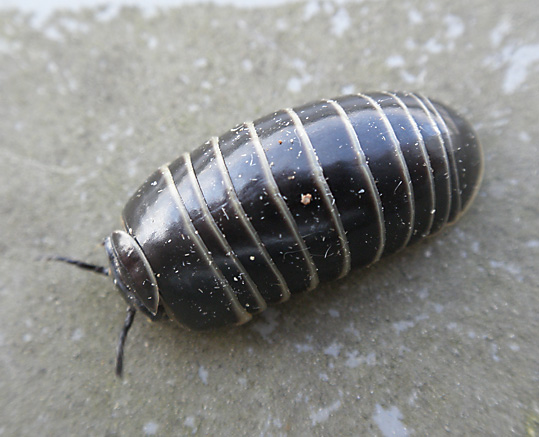
Specimen
photographed in Göttingen (Niedersachsen)
on July 1, 2009.
Subspecies
Original
description
Synonyms
Oniscus armadillo Linnaeus, 1758 (p. 637) (nomen oblitum; see note below)
Locus typicus:
"Europa".
Oniscus marginatus
Villers, 1789 (p. 187)
Glomeris marginata
(Villers, 1789)
Glomeris marginatus (Villers, 1789)
Locus typicus: "Europa.
In Gallia Australiori" (interpreted as
southern France).
Glomeris castaneus
Risso, 1826 (p. 148) (see note below)
Locus typicus:
Not specified. Alpes Maritimes (France),
inferred from work title.
Glomeris
marginata lucida Latzel, 1890 (see note below)
Note: The description of Oniscus
armadillo in Linnaeus (1758) is rather vague,
but Linnaeus gives a reference to his
pre-nomenclatural work Fauna Svecica (Linnaeus
1746) that contains a more detailed description.
Both descriptions together indicate that this
name denotes a mixture of Glomeris and
Armadillidium, which Linnaeus obviously failed
to distinguish. The description in Fauna Svecica
reads: "Totus niger, marginibus segmentorum
albis; macula alba sub femoribus posteribus in
singula incisura. Cauda obtusa, integra, nec
bifurca" ("Completely black, with the margins of
the segments white; a white spot beneath the
femora of the hind legs in every segmental
groove. Tail blunt, whole, not bifurcated"). The
black body with white segmental margins fits
both Glomeris marginata and several
Armadillidium species, but the white spots
beneath the hind legs are beyond doubt the
description of the tracheal system of the
pleon of Armadillidium. In addition, Linnaeus
(1746) writes "Habitat in pratis Gotlandiae".
Gotlandiae could refer to the island of Gotland,
but also to the "landsdel" of Götaland,
which is basically southern Sweden. No Glomeris
species occurs on Gotland island, but Glomeris
marginata is found in southern Sweden; however,
an occurence of Glomeris in meadows ("in
pratis") is very unlikely. Thus, the
morphological and ecological details of this
description clearly point to a species of
Armadillidium. However, in the original
description of Oniscus armadillo in 1758,
Linnaeus not only references his 1746
description in Fauna Svecica, but he also
describes the species now as: "Habitat in Europa
sub lapidibus. Pedes plures quam quatuordecim;
Segmenta corporis 10, praeter caput et caudam"
("Lives in Europe under stones. More than
fourteen legs; 10 body segments in addition to
the head and the tail"). Not only has the
habitat changed, but also the description now
clearly states that the animal has more legs
than an isopod and the count of body segments
also fits Glomeris, because if the collum is
attributed to the head, then Linnaeus´
description accurately gives the number of
dorsal tergites of Glomeris. Thus,
Linnaeus´ reference to his own work of
1746 could be interpreted as an erroneous
synonymy and the "official" 1758 description
clearly describes Glomeris marginata.
Nevertheless, I regard the name a nomen dubium
and also as a nomen oblitum and do not regard it
as the valid name of the present species.
Note: Glomeris castaneus was coined for brown
specimens, that otherwise are virtually
identical to Glomeris marginata. Therefore I
consider it to be a synonym. Brown specimens of
Glomeris marginata occur sometimes in wild
populations and are likely the result of
pigmentation gene mutations. Thus, they are
similar in origin to albinos and are therefore
often called "rufinos". Another name for these
rufinos is lucida.
Identification
Distribution
Biology
|

